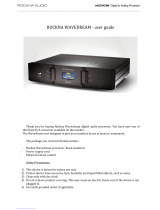
The HVE 820 headphone amplifier
6 | HDV 820
The HVE 820 headphone amplifier
The HDV 820 headphone amplifier is the result of Sennheiser's many
years of audio expertise and the perfect complement to its high-end
audiophile headphone range for the ultimate in sound quality and
performance. The HDV 820 offers consistently symmetrical signal
processing and extremely low harmonic distortion to ensure
unadulterated and perfect music enjoyment. Designed and
manufactured in Germany, the HDV 820 continues the success story
of its predecessor, the HDVD 800, and convinces with its black
design and enhanced components that provide even greater
precision and sound quality.
The HDV 820 is equipped with a high-resolution ESS SABRE
32
DAC
(digital-to-analog converter) that has a resolution of 32 bits and a
sampling rate of up to 384 kHz. The amplifier can also process
DSD256 files with a frequency of up to 12.3 MHz and features various
audio inputs and outputs, allowing you to choose the optimum
connection for your audio devices and headphones. The HDV 820
reproduces both digital and analog audio sources with superb sound
quality.
Fittingly for a product that gives such an incredibly pure sound
experience, the HDV 820 also inspires by its design. With its black
anodized housing and white LEDs, the HDV 820 perfectly matches
Sennheiser's HD 800 S flagship high-end headphones to deliver the
ultimate audiophile listening experience.
Features
• Symmetrical signal processing with exact signal transmission
over the entire frequency spectrum and extremely low harmonic
distortion
• Dynamic range of more than 120 dB, wide bandwidth and high
transient response due to short signal paths
• Outstanding ESS SABRE
32
DAC (digital-analog converter) with a
resolution of 32 bits and a sampling rate of up to 384 kHz
• Automatic adjustment of the sampling rate (44.1 kHz to 384 kHz)
• USB Audio (up to 32 Bit/384 kHz and up to DSD256)
• Can be used with up to four dynamic headphones
• 3 balanced headphone sockets (2 x 4.4 mm Pentaconn jack
socket, 1 x XLR-4 socket)
•High-quality XLR-3/¼"
(6.35 mm) jack combo socket for connec-
tion of unbalanced headphones
• High flexibility due to different connection possibilities:
– Digital inputs: S/PDIF coaxial/optical, USB
– Analog inputs: balanced XLR-3, unbalanced RCA
•Analog output: balanced XLR-3, level adjustable (for connection
of active loudspeakers or a power amplifier)
• Engineered and handcrafted in Germany






















